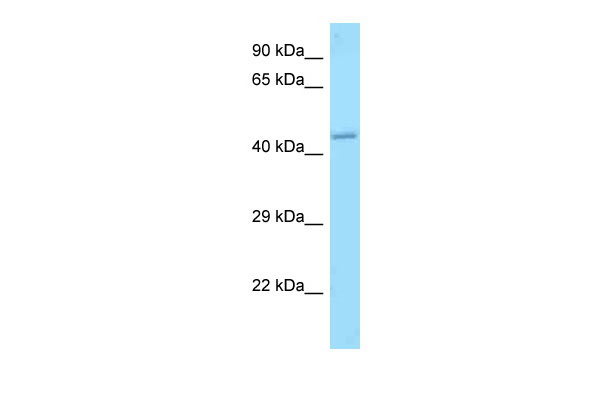Aplnr antibody - C-terminal region
Rabbit Polyclonal Antibody
- 产品详情
- 实验流程
Application
| WB |
|---|---|
| Primary Accession | Q9WV08 |
| Other Accession | NM_011784, NP_035914 |
| Reactivity | Human, Mouse, Rat, Rabbit, Dog, Horse |
| Predicted | Human, Mouse, Rabbit |
| Host | Rabbit |
| Clonality | Polyclonal |
| Calculated MW | 42266 Da |
| Gene ID | 23796 |
|---|---|
| Alias Symbol | APJ, Agtrl1, msr/apj |
| Other Names | Apelin receptor, Angiotensin receptor-like 1, G-protein coupled receptor APJ, MSR, Aplnr, Agtrl1, Apj |
| Format | Liquid. Purified antibody supplied in 1x PBS buffer with 0.09% (w/v) sodium azide and 2% sucrose. |
| Reconstitution & Storage | Add 50 ul of distilled water. Final anti-Aplnr antibody concentration is 1 mg/ml in PBS buffer with 2% sucrose. For longer periods of storage, store at 20°C. Avoid repeat freeze-thaw cycles. |
| Precautions | Aplnr antibody - C-terminal region is for research use only and not for use in diagnostic or therapeutic procedures. |
| Name | Aplnr {ECO:0000312|MGI:MGI:1346086} |
|---|---|
| Synonyms | Agtrl1, Apj |
| Function | G protein-coupled receptor for peptide hormones apelin (APLN) and apelin receptor early endogenous ligand (APELA), that plays a role in the regulation of normal cardiovascular function and fluid homeostasis (PubMed:22810587, PubMed:28663440, PubMed:28854362, PubMed:28890073). When acting as apelin receptor, activates both G(i) protein pathway that inhibits adenylate cyclase activity, and the beta- arrestin pathway leading to internalization of the receptor (PubMed:22810587, PubMed:28663440, PubMed:28854362, PubMed:28890073). APLNR/APJ receptor is also activated by mechanical strech in a G- protein-independent fashion to induce beta-arrestin signaling leading to cardiac hypertrophy (PubMed:22810587). However, the presence of apelin ligand blunts cardiac hypertrophic induction from APLNR/APJ on response to pathological stimuli (PubMed:22810587). Plays a key role in early development such as gastrulation, blood vessels formation and heart morphogenesis by acting as a receptor for APELA hormone (PubMed:28663440, PubMed:28854362, PubMed:28890073). May promote angioblast migration toward the embryonic midline, i.e. the position of the future vessel formation, during vasculogenesis (By similarity). Promotes sinus venosus (SV)-derived endothelial cells migration into the developing heart to promote coronary blood vessel development (PubMed:28890073). Also plays a role in various processes in adults such as regulation of blood vessel formation, blood pressure and heart contractility and protection from cardiac hypertrophy and heart failure (PubMed:22810587, PubMed:28371822). |
| Cellular Location | Cell membrane {ECO:0000250|UniProtKB:P35414}; Multi-pass membrane protein {ECO:0000250|UniProtKB:P79960}. Note=After exposure to apelin (APLN) or apelin receptor early endogenous ligand (APELA), internalized from the cell surface into an endosomal recycling compartment, from where it is recycled to the cell membrane {ECO:0000250|UniProtKB:P35414, ECO:0000250|UniProtKB:Q9JHG3} |
| Tissue Location | Expressed in coronary endothelial cells (at protein level) (PubMed:28890073). Expressed in the embryo, allantoic and endothelial precursor cells of the yolk sac at 8 days post-coitum (dpc) (PubMed:28663440). Expressed in the secondary heart field and somite at 8.25 dpc (PubMed:28854362). Expressed in fetal allantoic endothelial cells at 9 dpc (PubMed:28663440). Expressed in the allantoid and the invading fetal vasculature of the placenta at 9.5 dpc (PubMed:28854362). Expressed in endothelial cells adjacent to syncytiotrophoblast cells at 10.5 dpc (PubMed:28663440). Expressed weakly in the embryonic heart at 11.5 dpc (PubMed:26611206). Expressed in the adult heart (PubMed:26611206). Expressed in endothelial cells and cardiomyocytes and weakly expressed in fibroblasts (PubMed:10473142, PubMed:26611206). |
Research Areas
For Research Use Only. Not For Use In Diagnostic Procedures.
Application Protocols
Provided below are standard protocols that you may find useful for product applications.
REFERENCES
Devic E.,et al.Mech. Dev. 84:199-203(1999).
Carninci P.,et al.Science 309:1559-1563(2005).
终于等到您。ABCEPTA(百远生物)抗体产品。
点击下方“我要评价 ”按钮提交您的反馈信息,您的反馈和评价是我们最宝贵的财富之一,
我们将在1-3个工作日内处理您的反馈信息。
如有疑问,联系:0512-88856768 tech-china@abcepta.com.























 癌症的基本特征包括细胞增殖、血管生成、迁移、凋亡逃避机制和细胞永生等。找到癌症发生过程中这些通路的关键标记物和对应的抗体用于检测至关重要。
癌症的基本特征包括细胞增殖、血管生成、迁移、凋亡逃避机制和细胞永生等。找到癌症发生过程中这些通路的关键标记物和对应的抗体用于检测至关重要。 为您推荐一个泛素化位点预测神器——泛素化分析工具,可以为您的蛋白的泛素化位点作出预测和评分。
为您推荐一个泛素化位点预测神器——泛素化分析工具,可以为您的蛋白的泛素化位点作出预测和评分。 细胞自噬受体图形绘图工具为你的蛋白的细胞受体结合位点作出预测和评分,识别结合到自噬通路中的蛋白是非常重要的,便于让我们理解自噬在正常生理、病理过程中的作用,如发育、细胞分化、神经退化性疾病、压力条件下、感染和癌症。
细胞自噬受体图形绘图工具为你的蛋白的细胞受体结合位点作出预测和评分,识别结合到自噬通路中的蛋白是非常重要的,便于让我们理解自噬在正常生理、病理过程中的作用,如发育、细胞分化、神经退化性疾病、压力条件下、感染和癌症。






